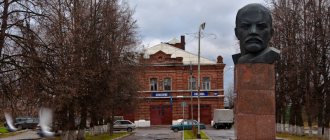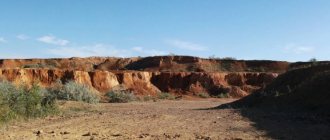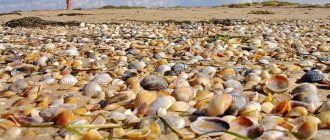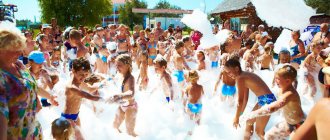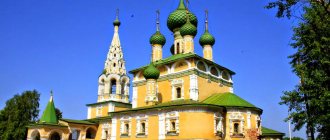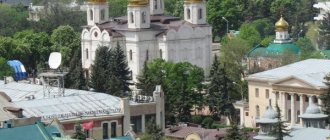Sights of Kaluga.
Kaluga is one of the tourist centers of the central region of Russia. Kaluga is a developed industrial city, but the city is interesting for tourists for other reasons. Konstantin Tsiolkovsky lived and worked here, so Kaluga has many attractions named after the scientist. Kaluga is the capital of astronautics. Lovers of historical values will discover the architectural monuments of Kaluga and the Kaluga region. There are many ancient temples and monasteries dating from the 17th to 19th centuries.
If you decide to travel to Kaluga and its surroundings, this is the right choice; you can easily find the city on the map. Let’s take a closer look at the names and descriptions of the main attractions of the city below.
Architectural sights of Kaluga
- The chambers of the Korobov merchants were erected in the city in the 17th century, in the style of ancient Russian architecture. The dynasty of local merchants, the Korobovs, lived here.
In the 19th century, the estate was transferred to the state, where city authorities opened a historical museum. Since 97 of the last century, the Korobov Chambers have been a branch of the Kaluga Local History Museum, and anyone can visit the exhibition.
- · Gostiny Dvor was built from the late 18th to early 19th centuries, in the style of classicism. The courtyard building consists of 14 buildings; famous guests liked to stay here, one of them was N.V. Gogol. At that time, active trade was carried out here by local merchants.
Today, concerts and festivals are regularly held in the restored Gostiny Dvor, and a fair takes place on weekends. In souvenir shops, tourists can buy souvenirs for themselves and loved ones, as well as try local treats.
- · Stone Bridge is a viaduct built in the 18th century. It consists of 15 arches, its length reaches 100 meters, and its height is 23 meters. This is one of the main attractions of the city; at that time it was a major transport artery with retail shops.
Today the bridge has gone through more than one reconstruction and has been completely restored. The bridge is open to tourists, and among newlyweds in Kaluga there is a belief that the newlywed spouse must carry the bride in order to avoid separation. Therefore, you can walk here and see many weddings.
- The House of the Noble Assembly was erected in Kaluga in 1856. Since then, balls, exhibitions and even elections have been held here. With the advent of Soviet power, the house of the noble assembly went to the house of pioneers.
Today, the architectural monument is occupied by the Regional Center for Additional Education of Children. Dance and vocal ensembles regularly rehearse here, as well as perform performances.
The architectural monuments of Kaluga include its numerous estates, which once belonged to prominent residents. Today, almost all of them have been restored and house museum exhibitions dedicated to their famous owners. If you want to see all the estates of Kaluga, it is unlikely that you will be able to do it in 1 day.
Kaluga "zero". Fresh memories of old Kaluga. Let's begin.
Whatever they say, Kaluga is getting prettier every year.
Despite all the efforts of local developers, lumberjacks of Zelenstroy, sculptors making cats and bags, water utilities, road workers, officials and Kaluga residents themselves.
That's how it used to be - everyone drank! Even the children were drinking. We still drink alcohol, about which there are statistics, but much less.
We bought some cars and are now driving. And we drink more culturally, in all sorts of pubs, and not moonshine at all, but all sorts of overseas whiskeys and wines, and not even hawthorn (it was banned), and if there is vodka, then, alas, it’s not local, we don’t make ours anymore, but we won’t for now about the sad things on the eve of the holiday.
What was the environment like before? What a fragrant air it was! The SDV plant was working. And the poultry farm was “Karachevskaya”, it also gave off an aroma. Now we only smell our own cars while stuck in traffic jams.
The mortality rate has decreased, the birth rate has increased, unemployment has fallen, even the cemetery is not so sad now.
You look into the distance and see hundreds of new cars, they say, there is a prospect. Before, it was just a bare field.
New factories, even metallurgical ones, do not spoil nature much, no matter what they say.
But the Grabtsevo airfield is completely lifeless. He had been dying for 20 years and was completely dead. Of these, it has been restored for at least 10 years, in words of course: projects, tenders, and that’s all.
But the church in Grabtsevo was restored.
Sidewalks. Just a few years ago, the online community of Kaluga was torn by moans about the tiles - they break heels, they are expensive, and they are laid incorrectly...
And then they walked around it, got used to the good things - that’s it, they fell silent.
Of course, in some places it was not done as it should be, but the difference is obvious.
Chicherina Street to the tiles. By the way, they also put a fence here, now the drunks don’t immediately fall under the wheels, but try to climb over the fence, they can be seen from afar.
Stepan Razin Street. How beautiful the asphalt was!
And here’s another huge “loss” – the Cosmos cinema. Typical Soviet horror. The feelings of those who were there in the back row for the first time are understandable, but the squalor was outright.
They built, of course, not a masterpiece, but it was still better than it was. Now two more buildings are being completed nearby, we’ll see what happens.
There was a lot of moaning about this “architectural monument”. From the outside it looked good, if not for the ever-falling stucco, but the inside of the building did not allow it to be used for commercial purposes. It’s okay that they demolished it, especially since the new building in its place repeats the old outlines; we’ll also evaluate it soon.
Another shopping center has grown on the site of the Romashka canteen, to the delight of Kaluga “Muscovites”, residents of the densely populated area of Moskovskaya Square.
Facades are the face of the city. They were repaired, but sluggishly, without a clear plan. Until the relay starts!
Our roads, of course, are bad, but this is in comparison with Europe, and if we compare them with neighboring cities, then they are not bad at all, and most importantly, they still make them. Here is Zarechnaya Street just 5 years ago:
And now:
The unfinished building has already turned into a residential building:
The abandoned apple orchard on Bushmanovka is also now being actively developed.
The village of Voskresenskoye, just a village...
Now it is surrounded on all sides by residential areas. The house may be typical, but it is your own.
On the Right Bank, the Soviet Union tried to build a huge industrial complex, but failed. There are many unfinished buildings left. Here is one of them:
Now it has been converted into a modern warehouse complex. Other abandoned buildings house the production of the Elmat plant and foreign investors. New factories were built from scratch in an open field.
Herzen Street, St. Basil's Church, 7 years ago.
And a year ago. The work is now finishing.
Assumption Church and Belarusian Market.
The temple has been restored and the market is still there, despite clumsy attempts to demolish it.
The dull, cramped and stuffy Pioneer cinema became a church again. Albeit with a very vaguely reminiscent bell tower.
There used to be deer in the park near the church, it’s a pity they were simply demolished, they could have put it in another place, instead they erected a huge cross... Last year the cross was moved, a monument to Peter and Fevronia was erected, and a nice park was laid out.
The pedestal at the Turyninsky Bridge was once “decorated” by a decommissioned concrete mixer, which quickly turned into scrap metal.
Now it’s not exactly a monument, but there is something unusual about it.
“Sharik” used to be just a monument, where during the day newlyweds came to drink champagne and break bottles, and at night bikers and car enthusiasts gathered here to roar their engines, and just get drunk. Now one of the most pleasant places in the city with a fountain, entertainment and Kote.
Gloomy city park with a broken fountain and paths.
In summer, the park smelled of barbecue; in winter, the remains of barbecue stalls stuck out.
The rides were supported by pieces of wood and word of honor.
Now everything is fine, only the Auto City is missing. There is no place to teach children traffic rules, yet there is clearly a demand for such entertainment - in the summer there are cars in every park.
Teatralnaya Street before the upgrade.
During the upgrade they overdid it - they cut down all the trees! Local entrepreneurs had to replant.
The biggest changes are on the Right Bank. In the open field, first an ice arena and then a swimming pool grew up.
Maybe a puppet theater will also be built nearby? There's still room.
New buildings on 65 Let Pobedy Street, March 2011.
It’s a pity that the pontoon bridge was washed away, it was such a cool place...
Now it’s also romantic: instead of a bridge, a short river walk for a few rubles... But not that...
And this is what the Gagarinsky Bridge was like. They managed to do it in time, I can’t imagine how they would get to the Right Bank now across the narrow old and broken bridge.
A rocket in the park... The photo shows March 2007, Putin will arrive in a few hours, the rocket has been painted and put into combat position.
Now the rocket is being painted again. The rocket has not changed, only the color of the pedestal has changed, and for some reason they forgot to put tiles around it.
Life in Kaluga has become better. And proof of this is the ever-increasing number of people wishing to move. They say that Kaluga will become a city of half a million. There will be work and housing for visitors, but where are the new roads, for example? There seems to be no line at kindergartens, but there is still a line at the nursery. There is no way they can move the market. Where are the new parks? I would like to believe that if not by the 650th anniversary, then by the 700th anniversary of Kaluga, we will solve all these problems.
Kirill SALNIKOV
Estates of the Kaluga region
- Golitsyn estate;
- Zolotarev's estate;
- Panskoye Estate;
- Manor Troitskoe;
- Tsiolkovsky House of Muses;
- Batenkov's House;
- Bilibin House;
- Tsvetaev House-Museum;
- Goncharovs' estate;
- House of Poznyakovs;
- House of Bogdanovs;
- House of Tsyplakovs;
- House-Museum of A. L. Chizhevsky.
Cultural attractions of Kaluga
- The house-museum of K. E. Tsiolkovsky is dedicated to the life of an outstanding scientist; here he lived for 29 years and wrote many of his works on aviation and astronautics. Tsiolkovsky was the founder of cosmonautics and rocket science in the Soviet Union.
In the museum you can see the interior in which the scientist lived, his personal belongings, household items and samples of his work. Here you can see his workshop, where he invented samples of his designs, and on the roof you can look through his telescope, from where Tsiolkovsky looked at the stars. Near the house there is a monument to Tsiolkovsky, with which all tourists willingly take memorable photos.
- The State Museum of the History of Cosmonautics named after K. E. Tsiolkovsky has been operating in Kaluga since 1967 and is one of the largest museums in all of Russia. The opening of the museum took place with the support of the world's first cosmonaut, Yuri Gagarin.
The museum displays a collection of rocket engines, as well as parts of the Vostok spacecraft and a model of the Mir orbital station. In total, the museum displays about 40 thousand copies. From here, international reporters often film for the whole world.
Having visited Kaluga, you should definitely visit such a unique museum.
- · The Kaluga Regional Museum of Local Lore has been operating in Kaluga since the end of the 19th century in the above mentioned estates. In total, the museum includes 19 mansions with exhibitions. The museum introduces its visitors to the history of the Kaluga region, the life of merchant families, the culture and way of life of Kaluga.
- The Art Museum in Kaluga has been operating since 1917. The museum's collection grew from the collection of the doctor N. Vasilyev, who donated it to the state. Today, many paintings by Russian artists from the 18th to the 20th centuries are presented here, and exhibitions of contemporary artists are also regularly held.
- The House of Masters is a museum in the format of a club, located in a wooden building, an architectural monument of the 19th century. The opening of the museum took place in the 90th year of the last century, after a major reconstruction of the mansion.
The museum presents exhibitions of decorative and applied arts and crafts of the Kaluga region. In addition to the exhibition, theme evenings, creative meetings and master classes are often held here, where every visitor can try himself in one or another craft.
The museum has a souvenir shop where you can buy exclusive souvenirs from manufacturers at low prices.
- The Craft Museum has been open in Kaluga since 1991, in an old merchant mansion. Here you can get acquainted with the life of the Kaluga people over the last three centuries. The museum's collection includes dishes, national costumes, embroidery, ceramics and many other exhibits.
The museum regularly conducts training classes on clay modeling and pottery, and after the master class, you can take home the dishes you made yourself.
History of Kaluga
As I already wrote, the official date of the founding of Kaluga is considered to be 1371, when it was first mentioned in a letter from the Lithuanian prince Olgerd Gediminovich to the Patriarch of Constantinople Philotheus with a complaint against the Grand Duke Dmitry Ivanovich, who took away a number of cities from him, incl. and Kaluga. Although all historians agree that a settlement existed on this site much earlier. Historical excavations confirm the existence of an ancient settlement here as far back as 5-7 thousand years BC.
Where did the name of the city come from? There are several versions. According to one of them, the city got its name from the Kaluzhka River, on which it was originally located. According to another, the name Kaluga comes from the words “kolo luga”.
At first, Kaluga was a border town on the border with Lithuania; it changed hands several times as a result of fierce battles.
In 1480, not far from Kaluga, the famous stand on the Ugra River took place, putting an end to the Tatar-Mongol yoke.
The main shocks hit the city in the 17th century. In 1606, the leader of the popular uprising, Ivan Bolotnikov, was here, later captured by deception in Tula.
In 1610, False Dmitry II hid here with his wife Marina Mnishek, and here, on the outskirts of Kaluga, he was killed by his bodyguard, the baptized Tatar prince Peter Urusov. False Dmitry II was buried in the Trinity Cathedral of Kaluga.
Read more about Kaluga in the article What to see in Kaluga in 2 days.
In 1611, Kaluga was again captured by the Poles; troops led by Dmitry Pozharsky were able to liberate the city. In 1618, Kaluga was almost completely devastated by the Zaporozhye army under the leadership of Hetman Zagaidachny, almost its entire population died.
In 1622, Kaluga was again destroyed as a result of a severe fire, and in 1654, 2/3 of its population died from a pestilence. In the same 1654, as a result of the reunification of Ukraine with Russia, Kaluga ceased to be a border city, and a period of peaceful development began.
Due to its favorable transport location, trade began to actively develop in the city. On December 15, 1775, Catherine II visited Kaluga and founded a governorship here, and also approved a regular plan for the development of the city, which determined its historical appearance for a long time. In 1796, the Kaluga province was founded. In the middle of the 19th century, Oka became very shallow, and trade fell into decline. From a large commercial and industrial center, Kaluga again turned into a small city of district significance. The Kaluga region with the regional center in the city of Kaluga was formed in 1944. Today Kaluga is a city with a population of about 350 thousand people. Various industrial enterprises operate in it, including foreign factories Volkswagen, Continental, Citroen-Peugeot-Mitsubishi Motors, Volvo, etc. The city has all the conditions for tourism: hotels of various levels have been built, including well-known global chains Sheraton, Ambassador, Hilton, Best Western.
Read more about hotels in Kaluga in the article Kaluga - where to stay for tourists.
Schedule and purchase of bus tickets HERE, see train and train schedules HERE
